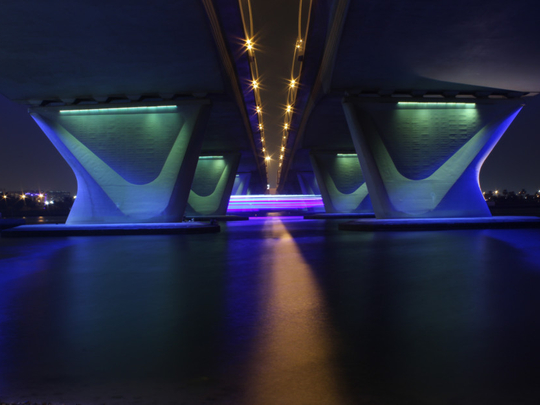
FOR CULTURE AND HERITAGE
Where: Abu Dhabi Heritage Village, near Marina Mall, Abu Dhabi.
Why: The Heritage Village shows Arab lifestyle of the past with an opportunity to capture a range of spices, old campfires and women weaving and spinning. Alongside heritage, you can photograph portraits with plenty of backdrops that show old buildings, the corniche or souqs.
Where: Sharjah Art Museum, Al Shuwaihiyeen area
Why: The lighting and interiors of the museum make this a unique way to capture Islamic architecture, while the 4,000 artworks are perfect for those willing to capture and share the story of Arab-themed art.
Where: Al Ain Palace Museum, Al Mutawaa, Al Ain
Why: For photographers who enjoy black and white photography, this museum is suitable for taking pictures of Bedouin heritage, forts and local culture. Black and white is one of the best photography practices, giving viewers an impression of a rich past.
Where: Al Ain Oasis, Al Ain
Why: Al Ain Oasis is an excellent location for photographers who enjoy outdoor photography and appreciate nature. The biggest factor in practicing photography there is the availability of natural light. Thus, one may not require additional lighting equipment. Additionally, the palm trees, oasis ecosystem and various other plantations makes Al Ain Oasis suitable to practice nature/wildlife photography.
FOR NATURE
Where: Ras Al Khor Wildlife Sanctuary, Dubai
Why: Regarded as one of the best eco-touristic sites in Dubai, the sanctuary provides a perfect blend of nature and flamingos. Having a long lens is helpful as you can photograph flamingos closely from the observation deck without disturbing them.
Where: Wadi Showkha, Ras Al Khaimah
Why: The advantage of this location is that one can practice more than just one type of photography. At Wadi Showka, one can practice night-long exposure photography. With the right aperture settings and with a still tripod, one can create a shot expressing stargazing. Whereas, one can spot animals like frogs or lizards but must be careful to photograph them. Additionally, one can also practice sports photography as canoeing is a popular activity there.
Where: Jebal Hafeet, here: Al Ain
Why: Lighting is a major factor that helps photographers get good shots at the mountain. Similar to Wadi Showka, one can practise long-exposure photography or could capture photographs of the curvy roads to imply the ‘S curve’, an aspect of photography that draws a viewer to follow a line.
FOR ARCHITECTURE
Where: Jazirat Al Hamra, Ras Al Khaimah
Why: Although a supposedly haunted village, it’s becoming increasingly famous for practicing documentary and landscape photography. Photographers can also experiment by capturing in low or mid angles to make forts and abandoned cars look more significant.
Where: Abu Dhabi Grand Mosque, Abu Dhabi
Why: Being the third largest mosque in the world, there are numerous areas in the mosque that can help you get a proper photograph whether it’s through a long or a short lens. Using a wide lens can be helpful in capturing the entire mosque while a basic lens can be used to capture particular domes or the interiors.
Where: Burj Khalifa, Dubai
Why: The iconic Burj Khalifa was once the third most Instagrammed building in the world for selfies, according to a study by AttractionTix. It’s a landmark that continues to draw photographers. Photographs taken from a high angle or aerial shots are often edited with multiple colour combinations to convey the busy city life, from the roads to the buildings. Low angle shots are taken in black and white to make the Burj Khalifa the centre of attention.
Where: Al Noor Mosque, Buhaira Corniche, Sharjah
Why: One of the biggest mosques in Sharjah, Al Noor Mosque is well lit at night right next to the corniche, inviting photographers interested in Islamic architecture. It’s best lit during the Sharjah Lights Festival every February.
FOR CITY/STREET LIFE
Where: The Walk, Jumeirah Beach Residence, Dubai
Why: It’s a popular street in Dubai with high-end shopping brands, hotels and plenty of restaurants around, making the location ideal to practice street photography. Illustrations on buildings and exclusive cars at the street are snap worthy too.
Where: Al Qasba, Sharjah
Why: The Central Souq has a unique design and is the shopping hub of Sharjah. It’s located next to the creek and the Eye of the Emirates. It’s one of the best places in Sharjah to capture the vivid city life. It’s best to practice photography during night time as the Central Market area is well lit.
Where: Dubai Water Canal and Garhoud Bridge, Dubai
Why: Both these landmarks are well lit at night. Practicing photography at the Water Canal is a great case of foreground and background. The canal being the foreground and the skyscrapers being the background. Whereas, the Garhoud Bridge is a location to practice symmetry in photography. Using high aperture can help the blue lighting reflect on the water.
Where: Al Bastakiya, Dubai
Why: Al Bastakiya traces the beginning of civilisation in Dubai, including old buildings, forts and abras. It remains to be one of the liveliest areas of Dubai. One can capture many aspects of street photography such as the abras and Arab souvenirs. A two-minute abra ride will take you to Al Ras, the first commercial business district of Dubai, and one can photograph trading activities.












